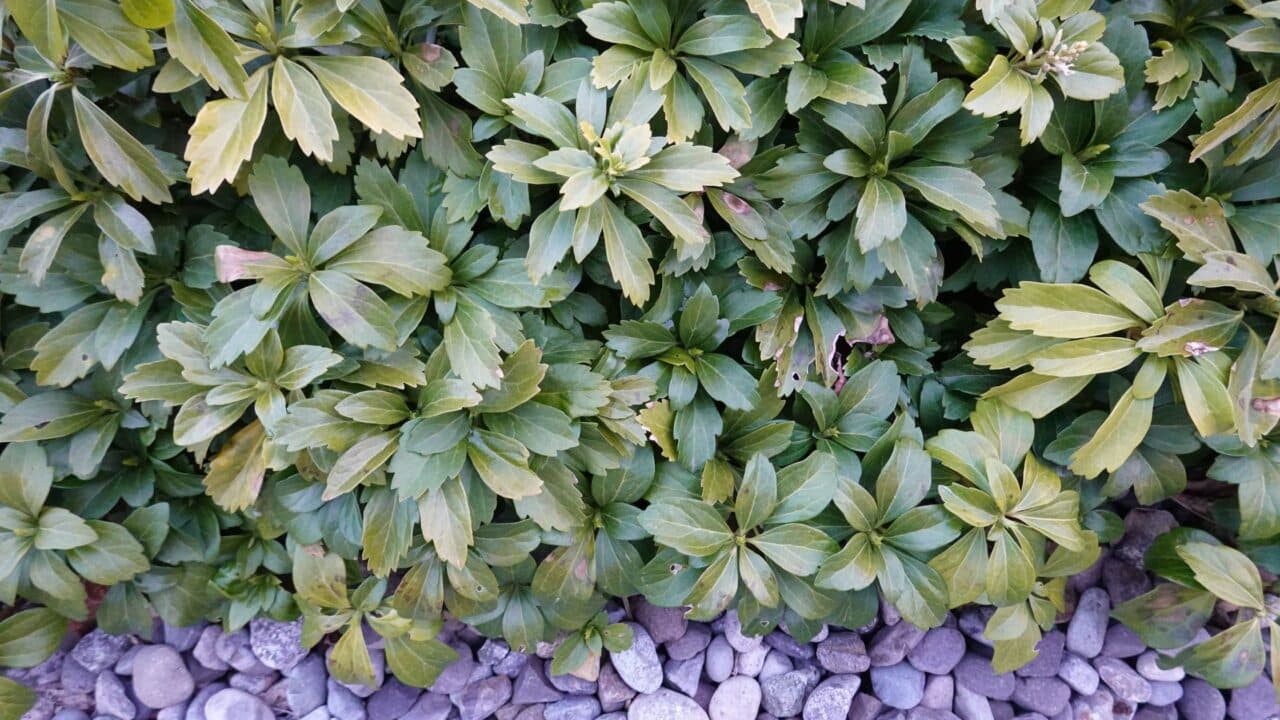🌱 Quick Overview
- Botanical name: Pachysandra terminalis
- Common names: Japanese Spurge, Carpet Box
- Type: Evergreen groundcover
- Zones: USDA 4–9
- Light needs: Full to part shade
- Soil: Moist, well-draining, slightly acidic
- Growth habit: Spreading mat via underground rhizomes
- Mature height: 6–10 inches
Life Cycle of Pachysandra
Pachysandra is a perennial evergreen — meaning it stays green year-round and comes back season after season. It spreads slowly but steadily by underground rhizomes, gradually forming a dense, low-maintenance carpet once established.
Here’s what you can expect through the year:
- Spring:New growth begins as temperatures rise. Tiny white flowers bloom in early spring (March–April), but they are not showy.
- Summer: Dense green leaves stay lush. Plants actively spread underground.
- Fall: Growth slows down but foliage stays green.
- Winter: Leaves may bronze slightly in extreme cold but usually stay intact, especially in sheltered spots.
When to Plant Pachysandra
The best time to plant Pachysandra is early spring or fall when temperatures are cool and moisture is more consistent. Avoid planting in the heat of summer unless you can water regularly during establishment.
- Spring (March–May): Ideal for strong root development before summer stress.
- Fall (September–October): Allows roots to settle before winter dormancy.
Container-grown plants can technically be planted any time the ground isn’t frozen, but cooler seasons lead to better results.
How to Plant Pachysandra
-
Clear the area of weeds, grass, and debris.
-
Loosen the soil 6–8 inches deep and mix in compost if the soil is compacted or sandy.
-
Test soil pH if possible — Pachysandra prefers slightly acidic conditions (pH 5.5–6.5).
-
Space plants 6–12 inches apart. They’ll fill in over time.
-
Water well after planting and keep moist until established (usually 6–8 weeks).
For larger areas, bare-root Pachysandra is often sold in flats and can be more cost-effective.
Maintenance Tips
Once established, Pachysandra is low-maintenance — but not zero-maintenance.
Watering:
-
Water weekly during the first growing season.
-
After establishment, water only during droughts.
Mulching:
-
Apply light mulch between new plants to retain moisture and suppress weeds.
-
Avoid burying the crown of the plant.
Fertilizing:
-
In early spring, apply a balanced slow-release fertilizer if needed.
-
Overfeeding can encourage rot or leggy growth.
Pruning:
-
Trim or mow in early spring to rejuvenate growth, especially in older patches.
-
Clean up damaged or discolored leaves.
Pests & Problems:
-
Volutella blight is a fungal disease that can occur in wet, crowded areas. Avoid overhead watering and maintain airflow.
-
Slugs may shelter under the dense mat in moist areas.
-
Root rot may develop in poorly drained or overwatered soil.
Wildlife & Ecology
Pachysandra is not native to North America (it’s from Japan), so it doesn’t offer high-value nectar or food for most pollinators or birds.
-
Deer and rabbits usually avoid it due to its bitter-tasting leaves.
-
It provides shelter for small insects and some ground-dwelling critters.
-
It can suppress native species if allowed to spread beyond intended beds — for that reason, use with care near natural areas.
Best Uses in Landscaping
Pachysandra is a workhorse for problem areas, especially under trees or along shaded paths. Use it where lawn grasses fail or maintenance needs to be minimal.
Top Applications:
-
Under spruce, pine, maple, or oak trees
-
Shaded foundation beds
-
Between stepping stones
-
Erosion control on shady slopes
-
Large shady swaths where mowing is impractical
Avoid using it too close to walkways where it can creep over edges or in small beds where spreading isn’t desired. It thrives most when allowed to form wide, uninterrupted drifts.
Companion Plants
While Pachysandra looks great on its own, you can combine it with other shade-tolerant, shallow-rooted plants:
-
Hostas (for texture contrast)
-
Ferns (for a native, woodland look)
-
Heuchera (adds pops of color)
-
Astilbe (works if the area stays moist)
Final Thoughts
Pachysandra isn’t flashy, but it’s one of the most reliable groundcovers for dry shade and a smart solution for planting under evergreens. Once it fills in, it offers a weed-suppressing, evergreen carpet with very little maintenance required.
If you’ve got a shady patch that nothing else seems to like — especially under a big spruce or pine — Pachysandra may be your best friend.

